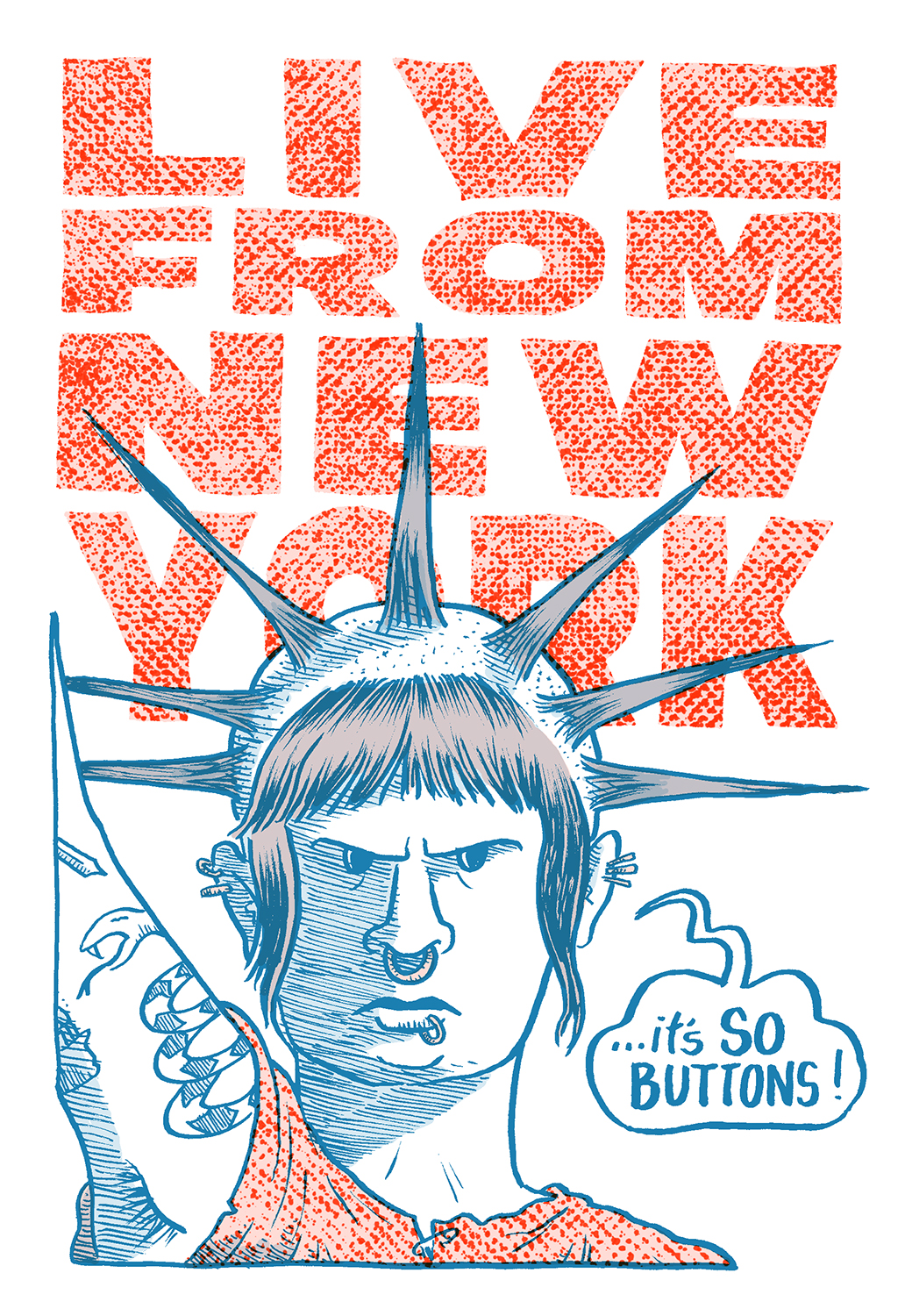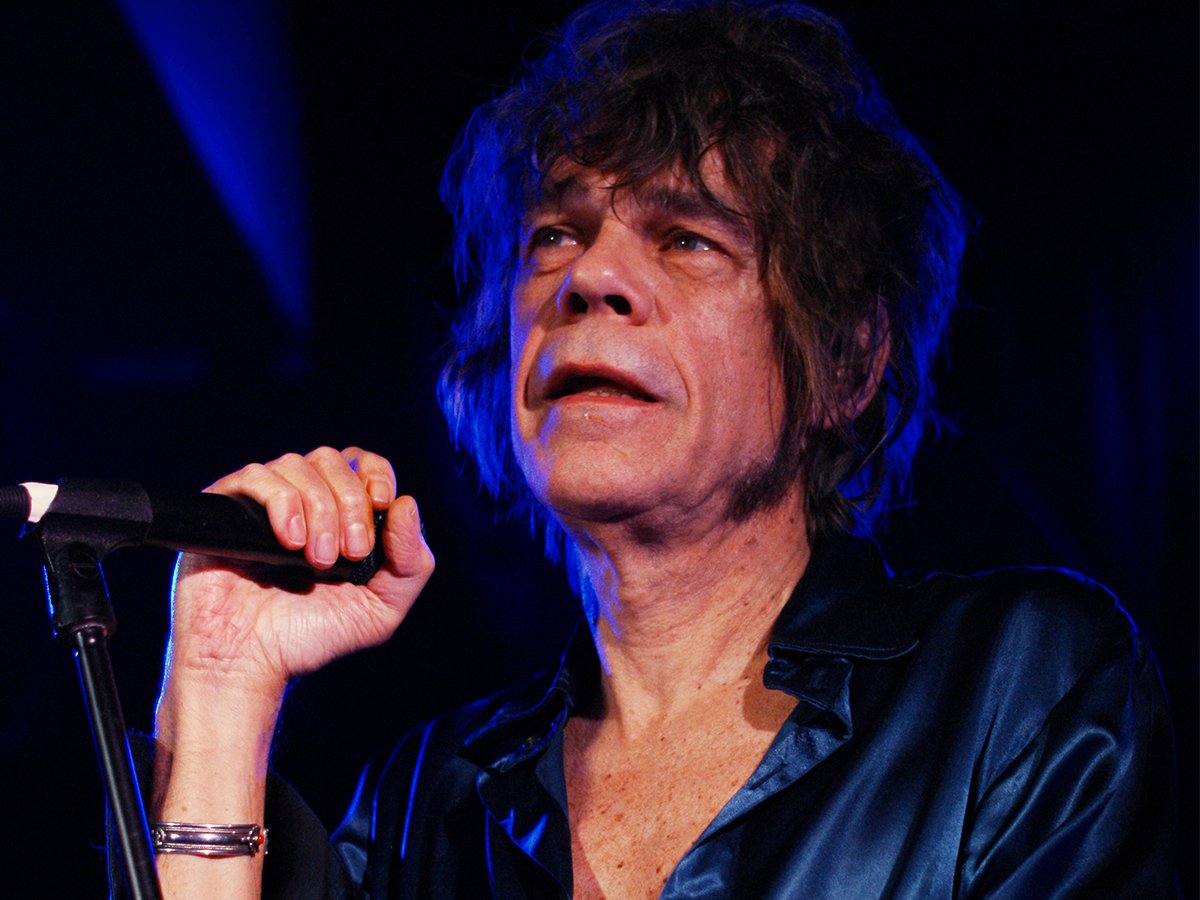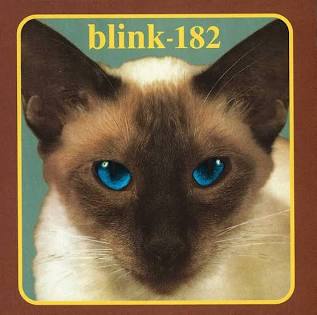Feature Image by JT Yost for the comic, “So Buttons” written by Jonathan Baylis
Sketch comedy is one of the greatest arts to skewer pop culture and politics. Live comedy shows go back to the days of vaudeville and music halls; with the advent of commercial broadcast TV, satire and sketch comedy eventually found a new stage. Programs like Your Show of Shows and the Smothers Brothers’ Comedy Hour in the United States or The Goon Show and Monty Python’s Flying Circus in the UK, put the absurdities of life under a microscope and highlighted its biggest gaffes and atrocities. The most popular and longest-running of these shows, Saturday Night Live, celebrates its fiftieth anniversary this year.
Having an empty spot in an ever-growing number of hours in a broadcast days, NBC would show reruns of Johnny Carson’s Tonight Show on late Saturday nights. Eventually, Carson wanted those reruns to be shown in the middle of the week, so he could take time off. Dick Ebersol was tasked with filling that time slot and approached Lorne Michaels about putting together a comedy show for a younger crowd. Michaels assembled a cast of “Not Ready For Primetime Players” to be broadcast from NBC’s 30 Rockefeller Studio 8H in New York City. Culled from comedy troupes including Second City in Chicago, the National Lampoon Radio Hour out of New York City, and The Groundlings from Los Angeles, Saturday Night Live was born. The show’s first five years were a launching pad for Dan Akroyd, Chevy Chase, Jane Curtin, and most infamously, John Belushi.
Depending on how wide your spectrum of punk rock spans, a counterculture show like Saturday Night Live naturally gravitated to some of the bands that were coming out of Hilly Kristal’s CBGB scene. Patti Smith Group was the first of these punk rockers to play the show on April 17, 1976, where she played a cover of the Them song “Gloria” and the Who’s “My Generation.” Other CBGB’s regulars the Talking Heads (2/10/1979) and Blondie (10/13/1979) would both go on to perform in 1979, and eventually both lead singers David Byrne and Debbie Harry would be guests later in the show’s run in some capacity.
While the original cast of SNL was known as the “Not Ready For Primetime Players,” one band’s performance during this show’s era proved that the world was not ready for them. Devo was the musical guest (10/14/1978) when Fred Willard hosted. Their sporadic movements and left-field take on the Rolling Stone staple “Satisfaction” made it impossible for the audience to tell if what they were seeing was real. However, one of the biggest moments in the first five years of the show came from Elvis Costello and the Attractions. When Sex Pistols’s manager, Malcolm McLaren, bungled the band’s visas the show was in a pickle without a musical guest for that week’s show. Elvis Costello and the Attractions stepped in and take their place. They were expected to play two songs, “Watching the Detectives” and “Less Than Zero.” However, during the show’s broadcast, Costello decided to play “Radio, Radio,” a song very critical of broadcast radio; a business NBC was still in at the time. Needless to say it was a long while before Elvis Costello was invited back on the show.
The 1980s ushered in a new cast and regime change for Saturday Night Live when Lorne Michaels left to take advantage of new opportunities that resulted from SNL’s success. This era of the show, while not well-received, springboarded the careers of comedians like Eddie Murphy, Billy Crystal, and Christopher Guest. During this time a lot of acts from England including punk rockers The Clash (10/9/1982), Billy Idol (1/28/1984) and second-wave ska bands The Specials (4/19/1980) and Madness (4/14/1984), served as musical guests. Yet, it was Halloween 1981 that saw one of Saturday Night Live’s most notorious moments. LA punk legends Fear were the musical guest at the (extorted) request of John Belushi in exchange for a cameo on that week’s episode. Fear had wanted some East Coast punks to show up to slam on and around the stage while they assaulted the living rooms of America. When punks from some of the East Coast scenes showed up, the end result was thousands of dollars worth of damage and a lifetime ban from the show.
By the time Lorne Michaels had returned in 1985, the show was in shambles and close to cancellation. Michaels did a hard reset of the cast. Established and future stars like Randy Quaid, Robert Downey Jr., and Joan Cusack starred in what’s known as the Weird Year. This season included a performance from the Replacements who gave a drunkenly sloppy performance of “Bastards of Young” and “Kiss Me On The Bus.” Before their second song Paul Westerberg and crew switched outfits with each other. In addition, Westerberg’s exclamation of “Come on, Fucker!” got the Replacements banned from the show. However, Westerberg returned as a musical guest in 1993 when Charlton Heston hosted the show.
The show’s credibility eventually recovered by the early 1990s. It was at this time some of the show’s biggest stars flourished. Recurring skits such as Wayne’s World became films and cast members Adam Sandler, Chris Farley, and Phil Hartman saw their statuses solidify as comedy icons. Phil Hartman’s hyperbolized impression of Frank Sinatra was always a bright spot of a show, but it was Sting’s take on Billy Idol that shines in this skit. (Please be aware this skit features language that may have been acceptable at the time, but should never have been in the first place.)
Nirvana made two appearances on the show first on January 11,1992 and then in fall 1993. It should be noted that they played in the middle of a five-show run with MC Hammer and James Taylor before their appearance and Robbie Robertson and C&C Music Factory after. Irish punks the Pogues played Studio 8H on St. Patrick’s Day 1990 (3/17/1990) as well as Los Angeles ska-punk-funk band Fishbone (3/23/1991), but the frequency of punk rock acts were sparse until the mid-1990s when Green Day made their first of three appearances on 12/3/1994.
After the show’s twentieth season, the show rebooted its cast once again. This time bringing future comedy star Will Ferrell and writer Adam McKay, while retaining some of the previous season’s cast members David Spade, Norm Macdonald, and Kids In The Hall transplant Mark McKinney. Punk had a resurgence around this time and with it the only Epitaph Records band to play the show to date, Rancid, made an appearance on 11/18/1995. A couple years later when ska was in the limelight again, No Doubt (12/7/1996) and The Mighty Mighty Bosstones (10/25/1997) would make SNL appearances. Henry Rollins made his only appearance on the show when Rollins Band was the musical guest with host Pamela Anderson (4/19/1997).
Robert Smigel’s “TV Funhouse” became a hit during this time mostly parodying the Saturday Morning Cartoons of the past, including School House Rock. During the March 14, 1998 episode, SNL aired “Conspiracy Theory Rock” with “Media-opoly”, a song which describes how all the big corporations own all of the major broadcast channels, control the news, and cover up stories that make them look less than favorable. This also included GE, NBC’s parent company. Unsurprisingly, the skit was pulled after its first airing, but as Smigel has said, it’s amazing it even made it on air in the first place.
As the show continued its broadcast into the 2000s, punk started to take a backseat from the music stage at SNL. However some of the newer cast came from some of the more alternative improv scenes. Comedy troupe Upright Citizen’s Brigade brought cast members Amy Poehler and Horatio Sanz to the SNL fold. UCB’s shows definitely kept the spirit of punk rock in improv circles with its in-your-face and unapologetic comedy that would take premises to extreme and weird places. After the year 2000, the only notable punk (adjacent) bands that played during this time were Blink-182 (1/8/2000), The Donnas (1/18/2003), and AFI (1/20/2007).
One Saturday Night Live cast member who has always worn his love for punk rock on his sleeve is Fred Armisen. After growing up and playing in local punk rock bands, Armisen started the band Trenchmouth after dropping out of art school and moving to Chicago. After making memorable appearances in movies like “Anchorman” and “Eurotrip,” Armisen was hired on to SNL in 2002. When CBGB’s was closing in 2006, Armisen and Amy Poehler went out to the Bowery and recorded a piece in character as Patti Smith and Lou Reed in front of CBGB’s talking about the venue’s eventual shuttering.
As almost a nod and preview to his two IFC shows, Portlandia and Documentary Now!, Fred Armisen made a fake punk rock documentary about an English punk rocker, Ian Rubbish and his band the Bizarros. An amalgamation of Joe Strummer, Johnny Rotten, and Billy Idol, Ian Rubbish sings songs in support of England’s ultra-conservative Prime Minister, Margaret Thatcher, much to the rest of the members’ disdain. However, the Fred Armisen skit that everyone points to is called “Punk Band Reunion at the Wedding.” Here, Armisen plays a father at his daughter’s wedding, who has agreed to let her dad’s old band play a song during the reception. What starts off as four middle-aged men making self-deprecating dad jokes turns into chaos as it’s revealed the band is called Crisis of Conformity, an 80’s hardcore punk band that performs their song, “Fist Fight!” to a crowd of confused, but mostly terrified wedding guests.
As punk has been more and more accepted, SNL seems to have put punk rock on the back burner in terms of skits and musical performances. While a lot of today’s counterculture takes cues from some of the punk rock movement and emo aesthetic, fans of the genres have aged into office jobs and raising kids. For some of them it was just a phase, but for others, it never goes away. A pre-recorded bit from season forty-five, “Corporate Nightmare Song,” can probably be described as Sum 41 with health and dental benefits.
It’s no coincidence that these two counterculture movements like Saturday Night Live and punk rock started to pick up steam around the same time. While it can definitely be argued that both of these arts developed into purer forms as time went on; punk rock and skit comedy’s time in the spotlight inspired future generations to make noise in their own scenes. Happy fiftieth Saturday Night Live and here’s to fifty more.




